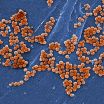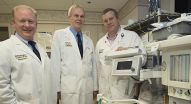(Press-News.org) BELLINGHAM, Washington, USA, and COLCHESTER, UK -- Swimmers looking to monitor and improve technique and patients striving to heal injured muscles now have a new light-based tool to help reach their goals. A research article by scientists at the University of Essex in Colchester and Artinis Medical Systems published today (5 December) in the Journal of Biomedical Optics (JBO) describes the first measurements of muscle oxygenation underwater and the development of the enabling technology.
The article, "Underwater near-infrared (NIR) spectroscopy measurements of muscle oxygenation: laboratory validation and preliminary observations in swimmers and triathletes," is published open access and appears in the current issue of JBO, published by SPIE, the international society for optics and photonics.
"There are limited methods available for real-time measurements of human performance underwater. This is especially true during dynamic exercise as occurs in sport," said JBO Associate Editor Marco Ferrari, a professor in the Department of Clinical Medicine, Public Health, Environment, and Life Sciences at the University of L'Aquila. "This paper is the first demonstration of the use of near-infrared spectroscopy to measure muscle oxygenation in athletes during swimming. It has implications not only as a new way to monitor sports performance, but also as a way of tracking and optimizing rehabilitation using water-based therapies such as cold-water immersion therapy."
Using spectroscopy, scientists can identify a material by deriving a unique chemical signature based on how the material interacts with light waves -- absorbing, reflecting, refracting, or otherwise altering various colors, or wavelengths, of light.
Near-infrared spectroscopy uses light waves from the near-infrared region of the electromagnetic spectrum, and is widely used in sensors for food and chemical quality control, in medical diagnostics such as blood sugar or oxygen analysis, or in monitoring brain or nerve functions.
Near-infrared spectroscopy is increasingly used in athletics, noted lead researcher Professor Chris Cooper, Director of Research Impact and Head of Research at the Centre for Sport and Exercise Sciences in the School of Biological Sciences at the University of Essex.
Technological advancements in device hardware and software, including new wireless, telemetric, and wearable devices, have made near-infrared measurements possible within a variety of field-based sports.
However, currently available portable devices are not waterproof, and the aquatic environment provides an exercise medium within which any physiological measurement is difficult to make.
The ability to monitor oxygen levels will provide swimmers with valuable feedback, and help ensure that working muscles have sufficient oxygen for sustained, strong performance and endurance.
"This work makes possible the measurement of peripheral muscle oxygenation changes in swimmers during aquatic exercise," Cooper said. "Innovative modifications to existing swim apparel, such as modified snorkels, have led to the attainment of systemic measures of oxygen consumption. Now, the development of a waterproof near-infrared device will facilitate measurement of muscle oxygenation and blood flow in a previously inaccessible exercise setting."
INFORMATION:
Co-authors with Cooper are University of Essex researcher Ben Jones and Marco Dat of the Dutch company Artinis Medical Systems.
The Journal of Biomedical Optics is published in print and digitally in the SPIE Digital Library, which contains more than 420,000 articles from SPIE journals and proceedings, as well as more than 200 eBooks. Abstracts are freely searchable, and an increasing number of full articles in the society's 10 peer-reviewed journals are published with open access. Approximately 18,000 new research papers, eBooks, and other publications are added each year.
Lihong Wang of Washington University in St. Louis is the journal's Editor-in-Chief.
SPIE is the international society for optics and photonics, a not-for-profit organization founded in 1955 to advance light-based technologies. The Society serves nearly 256,000 constituents from approximately 155 countries, offering conferences, continuing education, books, journals, and a digital library in support of interdisciplinary information exchange, professional networking, and patent precedent. SPIE provided more than $3.2 million in support of education and outreach programs in 2013.
Increases in excess fat adversely affect multiple cardiometabolic risk markers even in lean young adults according to a new study published this week in PLOS Medicine. The study by Peter Würtz from the University of Oulu, Finland, and colleagues suggests that, even within the range of body-mass index (BMI) considered to be healthy, there is no threshold below which a BMI increase does not adversely affect the metabolic profile of an individual.
Adiposity, or having excess body fat, is a growing global threat to public health. Compared to people with a lean body ...
December 9, 2014 -- Methicillin-resistant Staphylococcus aureus (MRSA) is a common cause of hospital-acquired infections, with the largest burden of infections occurring in under-resourced hospitals. While genome sequencing has previously been applied in well-resourced clinical settings to track the spread of MRSA, transmission dynamics in settings with more limited infection control is unknown. In a study published online today in Genome Research, researchers used genome sequencing to understand the spread of MRSA in a resource-limited hospital with high transmission rates.
Patients ...
SAN FRANCISCO (DECEMBER 9, 2014) -Common variations in four genes related to brain inflammation or cells' response to damage from oxidation may contribute to the problems with memory, learning and other cognitive functions seen in children treated for acute lymphoblastic leukemia (ALL), according to a study led by researchers from Boston Children's Hospital, The Children's Hospital at Montefiore, and Dana-Farber/Boston Children's Cancer and Blood Disorders Center.
The data, presented at the 56th annual meeting of the American Society of Hematology (abstract #856), suggest ...
A team of Massachusetts General Hospital (MGH) investigators has identified what may be a biomarker predicting the development of the dangerous systemic infection sepsis in patients with serious burns. In their report in the open-access journal PLOS ONE, the researchers describe finding that the motion through a microfluidic device of the white blood cells called neutrophils is significantly altered two to three days before sepsis develops, a finding that may provide a critically needed method for early diagnosis.
"Neutrophils are the major white blood cell protecting ...
Timing is key for brain cells controlling a complex motor activity like the singing of a bird, finds a new study published by PLOS Biology.
"You can learn much more about what a bird is singing by looking at the timing of neurons firing in its brain than by looking at the rate that they fire," says Sam Sober, a biologist at Emory University whose lab led the study. "Just a millisecond difference in the timing of a neuron's activity makes a difference in the sound that comes out of the bird's beak."
The findings are the first to suggest that fine-scale timing of neurons ...
Researchers from the University of Cambridge have used genome sequencing to monitor how the spread of methicillin-resistant Staphylococcus aureus (MRSA) occurs in under-resourced hospitals. By pinpointing how and when MRSA was transmitted over a three-month period at a hospital in northeast Thailand, the researchers are hoping their results will support evidence-based policies around infection control.
MRSA is a common cause of hospital-acquired infections, with the largest burden of infections occurring in under-resourced hospitals in the developing world. Whereas genome ...
The availability of a trace nutrient can cause genome-wide changes to how organisms encode proteins, report scientists from the University of Chicago in PLoS Biology on Dec. 9. The use of the nutrient - which is produced by bacteria and absorbed in the gut - appears to boost the speed and accuracy of protein production in specific ways.
"This is in some sense a 'you are what you eat' hypothesis,"' said senior study author D. Allan Drummond, PhD, assistant professor of biochemistry and molecular biology at the University of Chicago. "This nutrient that is absorbed through ...
AUDIO:
Nitrous oxide, often called laughing gas, has been used in medicine and in dentistry for more than 150 years. But researchers at Washington University School of Medicine in St. Louis...
Click here for more information.
Nitrous oxide, or laughing gas, has shown early promise as a potential treatment for severe depression in patients whose symptoms don't respond to standard therapies. The pilot study, at Washington University School of Medicine in St. Louis, is believed to ...
A new policy paper by a University of York academic calls for limits on the influence of the drinks industry in shaping alcohol policy because it has a 'fundamental conflict of interest'.
The article by Professor Jim McCambridge, of the Department of Health Sciences at York and academics at King's College London and the University of Newcastle, New South Wales, is published in this week's PLOS Medicine.
It says the concept of harm reduction has been co-opted by industry interests in public health debates about reducing the damage caused by alcohol. The paper argues ...
Is being located next to a big-name competitor always bad for your small business? A new study in the Journal of Marketing Research shows that contrary to accepted belief, the presence of a large, nearby competitor can actually boost the sales of smaller brands.
"When the owner of Los Angeles's Coffee Bean & Tea Leaf could not stop Starbucks from moving in next door, he at first admitted defeat," note authors Neeru Paharia (Georgetown University), Jill Avery (Harvard University), and Anat Keinan (Harvard University). "However, soon after, he was surprised to see his sales ...



